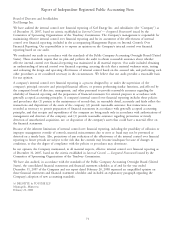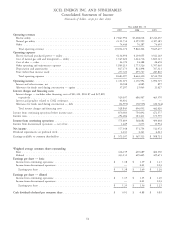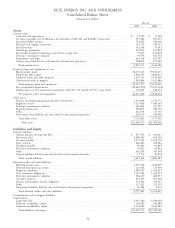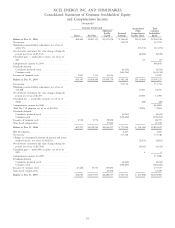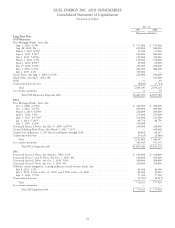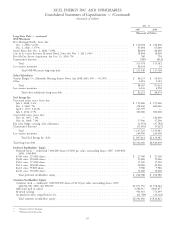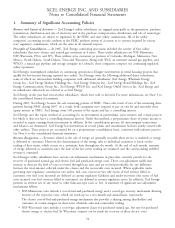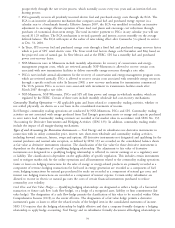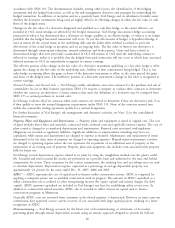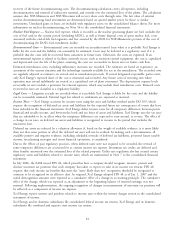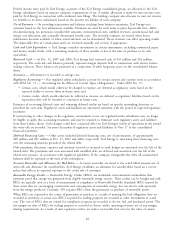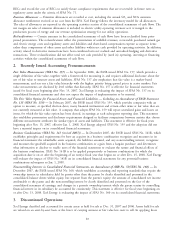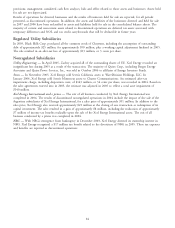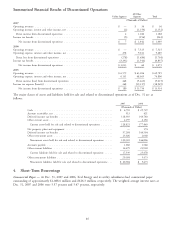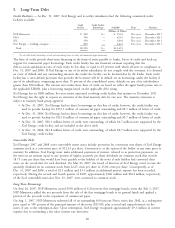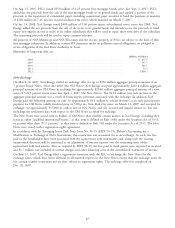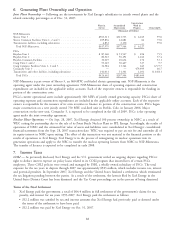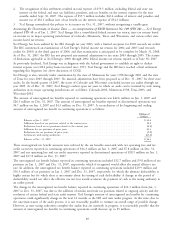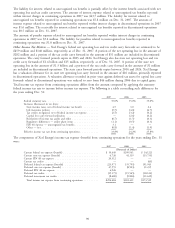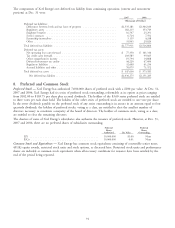Xcel Energy 2007 Annual Report Download - page 91
Download and view the complete annual report
Please find page 91 of the 2007 Xcel Energy annual report below. You can navigate through the pages in the report by either clicking on the pages listed below, or by using the keyword search tool below to find specific information within the annual report.recovery of the future decommissioning costs. The decommissioning calculation covers all expenses, including
decontamination and removal of radioactive material, and extends over the estimated lives of the plants. The calculation
assumes that NSP-Minnesota and NSP-Wisconsin will recover those costs through rates. The fair value of external
nuclear decommissioning fund investments are determined based on quoted market prices for those or similar
investments. Unrealized gains or losses are included with regulatory assets on the consolidated balance sheets. For more
information on nuclear decommissioning, see Note 16 to the consolidated financial statements.
Nuclear Fuel Expense — Nuclear fuel expense, which is recorded as the nuclear generating plants use fuel, includes the
cost of fuel used in the current period (including AFDC), as well as future disposal costs of spent nuclear fuel, costs
associated with the end-of-life fuel segments and fees assessed by the DOE for NSP-Minnesota’s portion of the cost of
decommissioning the DOE’s fuel-enrichment facility.
Environmental Costs — Environmental costs are recorded on an undiscounted basis when it is probable Xcel Energy is
liable for the costs and the liability can reasonably be estimated. Costs may be deferred as a regulatory asset if it is
probable that the costs will be recovered from customers in future rates. Otherwise, the costs are expensed. If an
environmental expense is related to facilities currently in use, such as emission-control equipment, the cost is capitalized
and depreciated over the life of the plant, assuming the costs are recoverable in future rates or future cash flow.
Estimated remediation costs, excluding inflationary increases, are recorded. The estimates are based on experience, an
assessment of the current situation and the technology currently available for use in the remediation. The recorded costs
are regularly adjusted as estimates are revised and as remediation proceeds. If several designated responsible parties exist,
only Xcel Energy’s expected share of the cost is estimated and recorded. Any future costs of restoring sites where
operation may extend indefinitely are treated as a capitalized cost of plant retirement. The depreciation expense levels
recoverable in rates include a provision for removal expenses, which may include final remediation costs. Removal costs
recovered in rates are classified as a regulatory liability.
Legal Costs — Litigation accruals are recorded when it is probable Xcel Energy is liable for the costs and the liability
can be reasonably estimated. External legal fees related to settlements are expensed as incurred.
Income Taxes — Xcel Energy accounts for income taxes using the asset and liability method under FAS 109, which
requires the recognition of deferred tax assets and liabilities for the expected future tax consequences of events that have
been included in the financial statements. Xcel Energy defers income taxes for all temporary differences between pretax
financial and taxable income, and between the book and tax bases of assets and liabilities. Xcel Energy uses the tax rates
that are scheduled to be in effect when the temporary differences are expected to turn around, or reverse. The effect of
a change in tax rates on deferred tax assets and liabilities is recognized in income in the period that includes the
enactment date.
Deferred tax assets are reduced by a valuation allowance if, based on the weight of available evidence, it is more likely
than not that some portion or all of the deferred tax asset will not be realized. In making such a determination, all
available positive and negative evidence, including scheduled reversals of deferred tax liabilities, projected future taxable
income, tax planning strategies and recent financial operations, is considered.
Due to the effects of past regulatory practices, when deferred taxes were not required to be recorded, the reversal of
some temporary differences are accounted for as current income tax expense. Investment tax credits are deferred and
their benefits amortized over the estimated lives of the related property. Utility rate regulation also has created certain
regulatory assets and liabilities related to income taxes, which are summarized in Note 7 to the consolidated financial
statements.
In July 2006, the FASB issued FIN 48, which prescribes how a company should recognize, measure, present and
disclose uncertain tax positions that such company has taken or expects to take in its income tax returns. FIN 48
requires that only income tax benefits that meet the ‘‘more likely than not’’ recognition threshold be recognized or
continue to be recognized on its effective date. As required, Xcel Energy adopted FIN 48 as of Jan. 1, 2007 and the
initial derecognition amounts were reported as a cumulative effect of a change in accounting principle. The cumulative
effect of the change, which was reported as an adjustment to the beginning balance of retained earnings, was not
material. Following implementation, the ongoing recognition of changes in measurement of uncertain tax positions will
be reflected as a component of income tax expense.
Xcel Energy reports interest and penalties related to income taxes within the interest charges section in the consolidated
statements of income.
Xcel Energy and its domestic subsidiaries file consolidated federal income tax returns. Xcel Energy and its domestic
subsidiaries file combined and separate state income tax returns.
81


